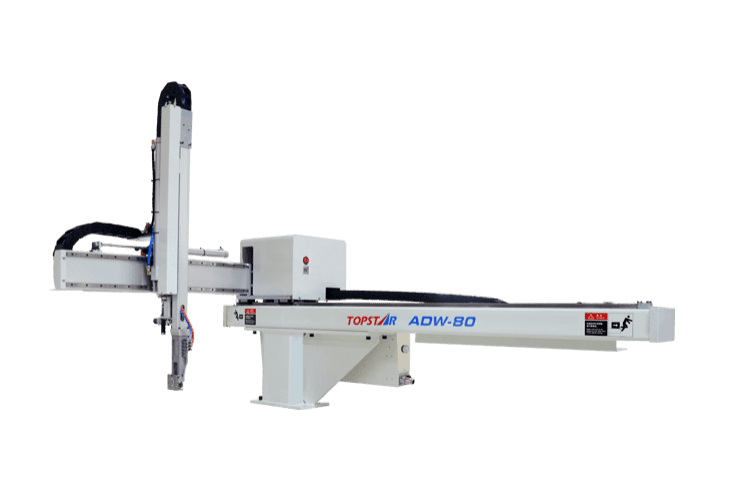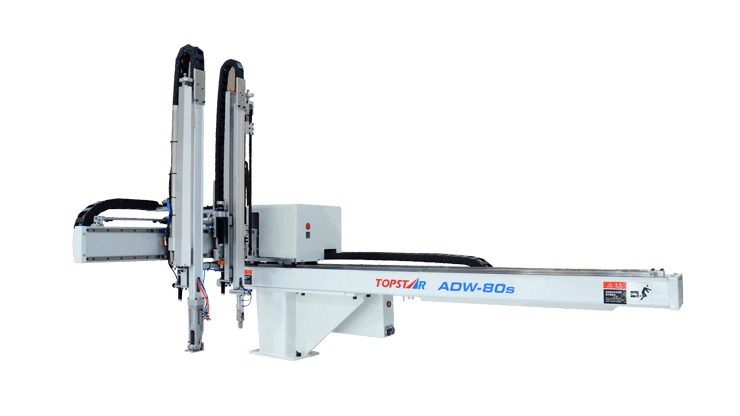How Injection Robot Maintain the Pace and Quality?
2022/04/26 By 兰兹


The insertion of injection robot in companies is one of the ways to walk together with innovation. We are in the age of automation, which seeks to increase the efficiency and productivity of industries. Recently, a novelty in the Brazilian market will contribute even more to this.
Robots for injection molding machines
Topstar, the supplier of industrial equipment, announced a line of industrial robots that can be coupled to injection molding machines. They can be used in production lines of different sizes.
What are injection molding robots?
Robots for injection molding machines are a type of industrial robot. An injection robot has a motorized and programmable mechanical arm to perform movements like human activity. The computer’s memory is responsible for the program that details what actions must be completed.
Industrial robots generally replace human work in repetitive, unhealthy, and dangerous situations. Even so, it must be versatile, robust, fast and accurate. It is common for them to have easy preparation devices and quick grip change systems.
There are several industrial robots, but we have four leading families when we talk about robots for injection molding machines.
Types of injection robots for injection molding machines
There are four main types of robots for injection molding machines:
Cartesian robots meet the diverse needs of injected parts and usually bring routines used in injection molding machines from the factory. It is one of the most common injection molding robots in the plastics industry, as it manipulates parts in the injection molding machine.
They can have one or two vertical axes (double arm) whose objective is to remove parts and injection channels from the mold simultaneously. They can also remove portions with suction cups and use tweezers to remove the injection channel.
Multi-axis robots (mechanical arms): injection robots that move in 4 to 6 axes and have great freedom of movement. Its programming is much more complex, but it is also very versatile and robust. Therefore, it is the most used model in the industry. It handles components, paints, welds, and automates manufacturing lines. However, it is not the most used for removing plastic parts from injection molds.
Sprue pickers (or manipulators): simpler and lower-cost robots. They feature three axes driven by servomotors or pneumatically. Its main objective is to extract the injection channel from the mold through tweezers (featuring a sensor to detect the presence or absence of the track) or suction cups. An injection robot removes simple parts or cuts the injection channels.
Side robots: used for the production of fast-cycle, thin-walled parts. They are also used for in-mold labeling technology. They can be swift and parameterized depending on the technology used. However, making minor changes to the previously defined parameters is possible.
What are the advantages of the robotic industry?
Robots for injection molding machines are used to automate the injection molding process. They handle plastic parts in the injection molding machine or place the finished pieces on a conveyor belt.
With this, it is possible to notice several advantages of injection robots in the plastics industry, such as:
- Greater standardization of parts, which reduces waste and increases yields;
- Reduced labor, molding, and finished product costs;
- More consistent quality of the parts produced;
- Greater productivity, efficiency, and flexibility;
- Shorter cycle times.
Injection molding robot: higher productivity

TOPSTAR operates in the market for importing and reselling thermoplastic machine tools and injection molding machines, highlighting the productivity gain as a great advantage of using robots for injection molding machines.
In his view, the company can gain greater productivity at scale without giving up the human workforce.
He explains that, using robots, “the production planning of companies can be very different! Injection robots can count on increased productivity by working different shifts. Entrepreneurs who follow the direction of robots stay with their companies and are more productive and closer to Industry 4.0”.
Industrial robots are essential to maintain the pace and quality.
Ortega also points out that “industrial robots have become essential to maintain the pace and quality of production in plastic processing companies. Executing repetitive cycles with precision, speed, strength, and resistance reduces losses, increases productivity, and ensures injected parts within the calculated parameters, something impossible to achieve with manual work”.
Using injection robots for injection molding machines in industrial processes gives companies a competitive advantage due to increased productivity and quality of the parts produced. With automation, it is possible to guarantee to end customers the delivery of reference products at a competitive price. In other words, it can improve your sales!
Does your company use lubricants for the plastics industry correctly? These substances are essential for safe and economical production, whether liquid or semi-solid.
Understand better about the importance of lubricants for the plastic industry!
Importance of lubricants for the plastics industry
Plastic industry lants play a crucial role in preserving machinery and equipment. The machinery has many components and elements that remain in constant motion daily. This means the friction between the parts can directly contribute to their wear.
Therefore, the use of lubricants becomes essential for the maintenance of factory assets, as well as for its productivity. But this is not the only importance of oils for the plastics industry. Consequently, we see higher quality delivery.
Injection Robot Manufacturing
Injection robot is a popular manufacturing process, ideal for creating precise parts with complex shapes, all without leaving too much material waste behind. Typical applications include packaging, automotive dashboards, mechanical parts like gears, and even popular children’s toys.
There are so many motors needed that, in the end, the robot consumes a lot of energy. They deliver almost no performance. It is no coincidence that industrial robots have only one arm and fewer degrees of freedom. Building an associate with 7 GDL rotors is so expensive that it is not worth it.
TRENDING POSTS
HOT TOPIC
- Air Chillers
- AP-RubberPlas
- Automation changed engineering
- automation of injection molding robots
- Bench Injection Molding Machine
- Cabinet dryer manufacturers
- Cabinet dryers
- CNC Drilling Machine
- CNC Drilling Machines
- cnc engraving machine manufacturer
- cnc laser cutting machine manufacturer
- CNC Machine for Sale
- CNC Machine Manufacturing
- CNC Machine Tool
- CNC machine tool product
- CNC Machining Center
- CNC wood carving machine
- Cooling system
- Cross-Walking Single Axis Servo Cylinder Robot
- Cross-Walking Single-Axis Servo Cylinder Robot
- Cross-Walking Three-Axis/Five-Axis Servo Driven Robot
- cross-walking three-axis/five-axis servo-driven robot
- Dehumidifier Dryer
- delta parallel robot
- Desktop Injection Molding Machine
- Desktop injection molding machines
- Desktop Molding Machine
- Desktop Plastic Injection Molding Machine
- direct clamp injection molding machine
- Direct clamp injection molding machines
- Dosing & mixing system
- Drilling Centers
- Drying and dehumidification system
- drying and dehumidifying equipment
- Drying and Dehumidifying System
- drying system
- effective and efficient. Cabinet dryers are also used in other industries where large quantities of material need to be dried
- elbow hydraulic injection molding machines
- Feeding And Conveying System
- Five Axis Machine Center
- GMU-600 5-Axis Machining Center
- Granulating & Recycling System
- Honeycomb rotor dehumidifier
- horizontal injection molding machine
- Horizontal Injection Molding Machines
- Horizontal Injection Moulding Machine
- Horizontal Mixer manufacturer
- How The CNC Machine Works
- Industrial robot
- industrial robot parts
- industrial robot supplier
- Industrial robots
- Industry Chain
- Injection Manipulator
- Injection molding
- Injection molding automation
- Injection Molding Automation Solution
- Injection molding machine
- Injection Molding Machine Factory
- Injection Molding Machine Manufacture
- Injection molding machine procurement
- injection molding machine with a robot
- Injection molding machines
- injection molding plant
- Injection molding robot automation
- Injection Moulding Robots
- Injection Robot
- Injection robot arm
- Introducing Injection Robot
- It is the best choice for drying large quantities of material at once. Cabinetmakers use these machines because they are fast
- large injection molding machine
- Learn what industrial automation and robotics is
- low speed sound-proof granulator
- machine plastic molding
- make sure to add some! Improvements (2) Keyphrase in introduction: Your keyphrase or its synonyms appear in the first paragraph of the copy
- manufacturing
- micro injection molding machine
- middle speed granulator
- Mini CNC machine manufacturers.
- Mold Temperature Control System
- molding material Dehumidifying System
- New electric injection molding machine
- nitrogen dryer manufacturer
- nitrogen dryer system manufacturer
- Oil type mold temperature controller
- Outbound links: No outbound links appear in this page. Add some! Images: No images appear on this page. Add some! Internal links: No internal links appear in this page
- plastic forming equipment
- plastic injection machine
- plastic injection molding
- Plastic injection molding machine
- Plastic Injection Molding Machines
- plastic injection robot
- plastic molding press
- plastic-molding machine
- powerful granulator
- Powerful Type Sound-Proof Granulator
- production of plastic seats
- robot injection molding machine
- robot manufacturing companies
- Robotic arm for injection molding machine
- robotic injection molding machines
- robotics in injection molding
- SCARA robot
- Service-oriented manufacturing
- Servo Cylinder Robot
- servo driven robot
- Servo Driven Robots
- servo injection robots
- Servo-Driven Robot
- Setup of injection machine
- Silicone Injection Molding Machine
- six-axis industrial robot
- Stainless Hopper Dryer
- swing arm robot
- toggle clamp injection molding machine
- Topstar
- Topstar Engineering
- Topstar injection molding intelligent
- Topstar Scara Robots
- Useful Injection molding machine
- Vertical machining centers
- volumetric type blender
- water distributor
- x carve CNC
